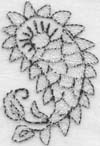Section 2 == *script chart*; *positional chart*; *more help*
The jīm series includes jīm ("j"), che ("ch"), ḥe ("h"), and ḳhe (a kind of throat-clearing sound not really expressible with English consonants). The letter che is the counterpart of the unaspirated "cha" (also often rendered as "ca") in Devanagari.
Note that ḥe is not the most common letter for the sound of "h"; instead, the round little chhoṭī he (see section 8.1) from the bottom of the chart is used. The ḥe we are discussing now is often called baṛī ḥe , in order to contrast it more effectively with chhoṭī he . Like its more common cousin, this baṛī ḥe sometimes creates special phonetic effects in pronunciation (see sections 8.2 and 8.3).
Note also that ḳhe is an entirely different sound from the Indic aspirate "kha" used, for example, in khānā and dekhnā . It is a guttural, and its nearest equivalent is supposedly the Scottish pronunciation of the "ch" in "loch." The letter ḳhe , since it's Arabic rather than Indic in origin, is expressed in Devanagari script by "kha" with a dot under it.
The letter vāʾo is, like alif , a non-connector. That means that it has no special initial or medial form. And its final form happens to resemble its independent form entirely, so it is almost as easy as alif to learn to recognize.
The letter vāʾo is a semivowel. That means that if it's the first letter in a syllable, it sounds like a consonant; and if it's the second letter in a syllable, it sounds like a vowel. We have a somewhat parallel case in English: note the difference between the consonant-"o" in "one" and the vowel-"o" in "no." (Though "one" is unusual, and "only" and its ilk are far more common of course.) If vāʾo is the first letter in a syllable, it sounds like "v" or "w" or halfway in between, as the speaker finds convenient (just like the Devanagari letter "va/wa"). If vaa))o is the second letter in a syllable, it sounds like either "o," "uu," or "au," according to the requirements of the word. Thus in Urdu the words to ("then") and tū ("you") normally look the same and can be distinguished only by the context. (For more detail, see section 5 on diacritics.) This kind of thing is a bit aggravating, but not nearly so much, in practice, as some of the more bizarre features of English spelling.
An extra, unpronounced or barely-pronounced vāʾo tends to occur in a number of words borrowed from Persian. Examples include ḳhvud ("oneself") and tanḳhvāh ("salary"). For further discussion see *Chapter 4, Section 2* of "A Practical Handbook of Urdu Meter."
